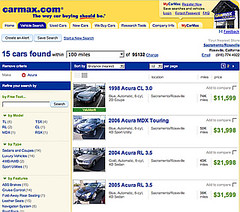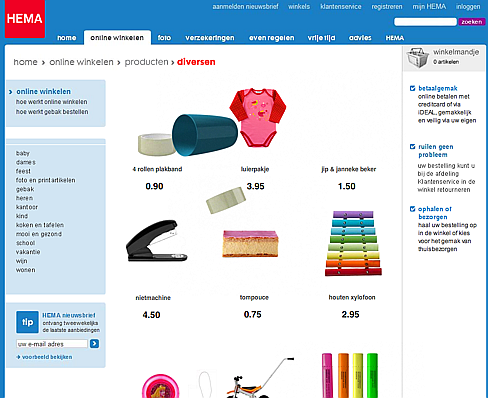She finishes up the article with a stab at redesigning the carmax.com search example more as a true car finder using a pattern I tend to call Refining Search. Others have called it a Faceted Search. Theresa describes it as an Ultra Rich Search. The best example of this is in kayak.com and roost.com (which has an absolutely superb house finding tool).


Theresa applied a real-time, iterative filter refinement ala roost.com
Where this type of patterns is really useful is when there is a large body of items that have clear facets (like size, color, brand, flight time, price, #bedrooms, texture, etc.). The mistake that most people make when implementing a refining search is not following some simple rules:
Refine in real-time
Clicking a bunch of check boxes or changing text parameters and then having to scroll down and find the Submit button is a ridiculous exercise to put the user through. The user is in an exploration flow. Don't break their flow with needless hunting for the submit button. What is the purpose? Hunting for product or hunting for your interface elements?
This is the ebay model. While it does a good utilitarian job of refinement... it is painful to experience.
eBay requires you to hit the submit and get a refresh to see next iteration
Avoid one-at-a-time experience
Some choose to avoid real-time filtering since it can be noisy to continue to refresh the display on each click (I talk about this as an Anti-Pattern, called One-At-A-Time-- forcing users to wait for updates on each click.) This is easily resolved by waiting to trigger the search until the user has not clicked for some small amount of time. With this mechanism you can click, click, click, pause... then search instead of click...search..click...search...click...search. We employed this technique on Yahoo! for Teachers.
In Y! Teachers you can click multiple filters without a reload. Waits for activity to stop.
Keep it smooth
Use Ajax or other in-page remote scripting to smooth out the load. Don't refresh the page! You will break the user's flow. The page will probably bounce back to the top. It will suck. Don't do it! Use a simple progress animation overlayed lightly on the content area to direct their attention to where the results will be.
Make the filters easy to Tweak
Try to avoid making the user type in values. Use sliders where it makes sense. The problem with sliders is the granularity of control and dexterity it requires to manipulate them. But if the values are large (like house prices) or there may be confusion about how to input the data (like using comma or not or whether to include the last 3 zeroes on house prices) a slider can avoid the ambiguity.
Make the filter controls easy to manipulate
Using simple check box on/off is the simplest approach to binary filters. You can visually treat them to make them not so busy... but keeping it looking like a checkbox is good since it is easy to understand.
Roost provides nice filters that are easy to work with
Keep the Context
Watch out for too many collapsible areas. Don't use accordions. Nobody wants to have to open an close each area one at a time to do filtering. And you need to see the full context to know how you have it filtered.
Y! Autos Car Finders uses large, klunky collapsible areas partly to hide a very large set of filters
Make it easy undo filtering
Just an undo all filters is a nice way to start a search over.

Roost has a simple reset
Provide a way to save & compare items for later
Being able to select items that get found, save them for comparison later is powerful for product choices. Roost lets you "highlight" properties. It remembers all hightlighted properties and at any time you can choose to view only those you have saved in this manner.

Blogged with Flock

